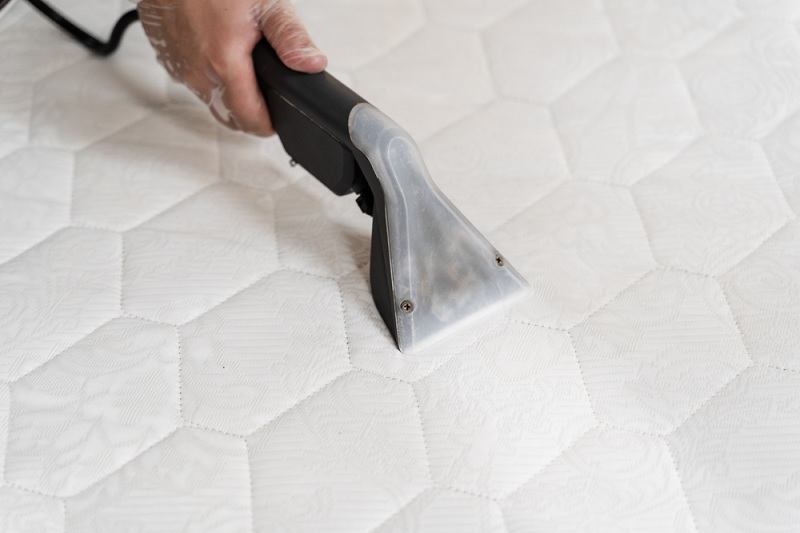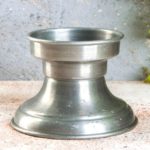Did you know that we spend roughly a third of our lives in bed sleeping? A third! That doesn’t even count the time we just chill out, read, play games, watch TV, or even eat in bed.
This all amounts to one thing… Our beds are havens for bacteria, dust, and dirt! This is why we need to clean our beds and bedding regularly. And yes, this does mean the mattress as well!
So, cleaning the sheets, pillowcases, and duvet is fine, but how do you go about cleaning the mattress? It’s not as if you can squeeze and squish it down into a washing machine!
The task is easier than you might think. And you can find out all the juicy details about cleaning a mattress below.
Follow the step-by-step guide below to clean your mattress at home.
How to Clean a Mattress
Tips to keep in mind
- Remember to clean all sides of your mattress.
- Don’t saturate your mattress in water. You should use very little liquid to clean the whole surface.
- Always read the care label on your mattress to find out how it should be cleaned and with what cleaning solutions.
- Try and hoover your mattress multiple times a year so that you can keep as much debris and dust at bay. This basic action can also prevent allergy flare-ups.
- Remove stains from the mattress as soon as they appear.
- Remember that you have to dry your mattress before you start using it again!
- Turn your mattress often (or as advised by the manufacturer).
- Keep your mattress cleaner for longer by using mattress toppers, protectors, and towels to protect the mattress itself. These items are usually a lot easier to clean as well!
- Always do a patch test to ensure the cleaning solution doesn’t damage the mattress.
- Use clean, cold water on the mattress. Don’t use warm/hot water because this could set stains on the surface.
- Get someone to help you lift and move the mattress around.
- Air your mattress regularly because this can help to remove pesky scents from it. This is very simple and effective because you can do this when you strip your bedding off to clean it!
- Try not to eat in bed, as that’ll limit how many stains you have to deal with!
Let’s dive into the cleaning.
Option 1: General clean
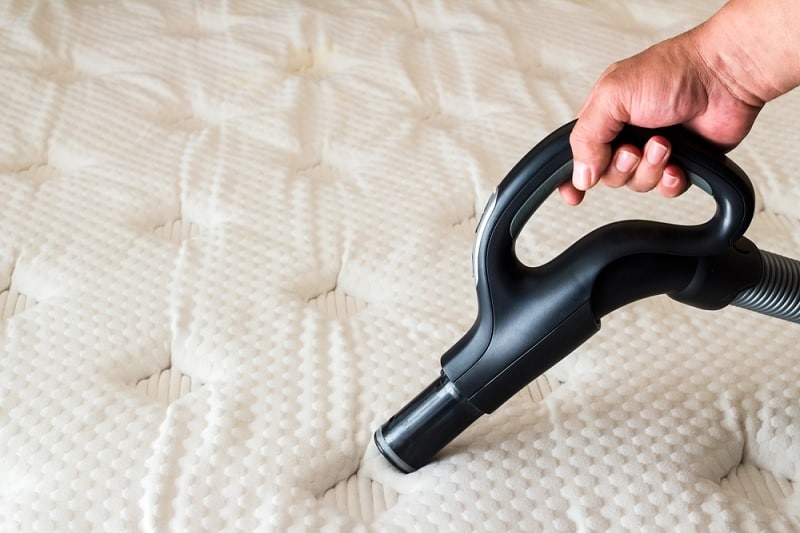
- Remove the bedding from the mattress. It’s a good idea to pop these items in the wash at this point.
- Clear the area around the mattress so you have a tidy workspace. Move any obstacles out of the way.
- Prepare your tools.
- Open the window to allow fresh air to circulate inside the room.
- Make sure the attachments and tools you’re going to use are clean and, if not, clean them accordingly.
- Hoover your mattress with the upholstery attachment on the hose. This will remove loose debris from the surface, for example, dead skin cells, dust mites, hair and dust. Take your time doing this—you need to cover every inch of the surface! As well as using a vacuum cleaner, you could also use a carpet cleaner for this task.
- Repeat the steps above for the other side of the mattress.
- While you’re at it, you may as well vacuum the bed frame and around/under the bed. This will stop any dust from landing on the mattress later on.
- Treat any stains you see on your mattress. This could be anything including food, blood, and urine (pet and human varieties!)
- When treating stains, it’s better to get rid of them as soon as they appear because old blemishes are usually hard to remove. Keep this in mind going forward.
- Treat the stain with an appropriate cleaner. This could be something natural or a shop-bought chemical solution, like Easylife Mattress Stain Remover or an enzymatic cleaner like Simple Solution Extreme Pet Stain & Odour Remover (for biological waste).
- Depending on the treatment you’ve used, you may have to leave your mattress alone for a few hours. For example, if you used cold water and washing up liquid to remove a fresh blood stain, you’d have to wait a few hours for the mattress to dry properly.
- When the mattress is free of stains, you can sprinkle an even layer of bicarbonate of soda (baking soda) all over the surface.
- Wait half an hour.
- Hoover the entire surface again, and any pesky odours should be neutralised by now.
- If you’re happy, you can leave your mattress to air dry. You shouldn’t sit, sleep or re-cover your mattress until it’s dry.
- When the mattress is dry, you can use it as usual.
Note: If your mattress is stain-free, you can skip all the steps above that talk about removing stains!
Option 2: Steam clean your mattress
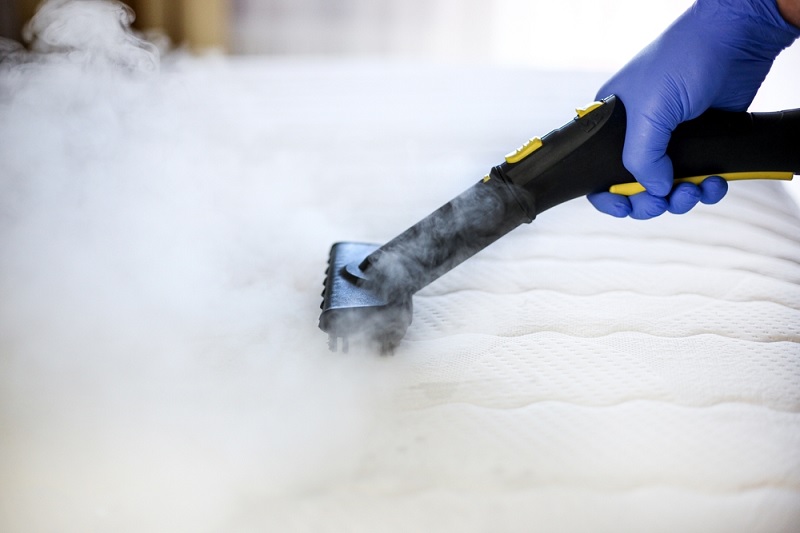
Follow the steps above, but instead of sprinkling bicarbonate of soda over your mattress to clean it, clean it with a steamer.
This process can be a bit more time-consuming and can be more of a workout for you, but it may yield better results, particularly if your mattress is heavily stained.
Just remember to clean the sides of your mattress if you’re going to try this method, and don’t get your mattress too wet because it will take ages to dry.
Option 3: Call a professional cleaner out to wash your mattress
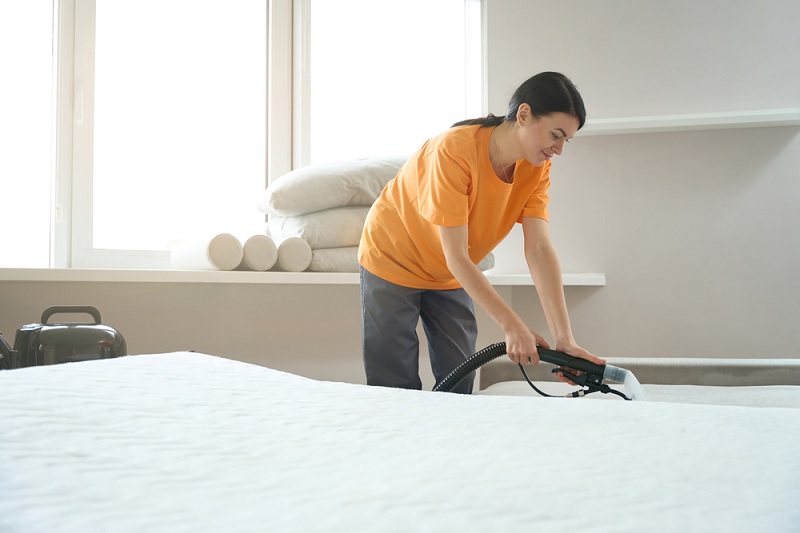
If you’re having problems cleaning your mattress, you could always ask a professional to help you out.
Pros normally use different tools and cleaning products to what we have at home, and these solutions can ensure mattresses are odour, stain and bacteria-free by the end of a clean.
To find a professional mattress cleaner near you, do a quick online search. And before you commit to anything, do your homework (read reviews, ask questions, and read up on the services being offered)!
There will be a fee for this work, so prepare in advance so you won’t be hit with an unexpected bill at the end.

How to Clean a Memory Foam Mattress
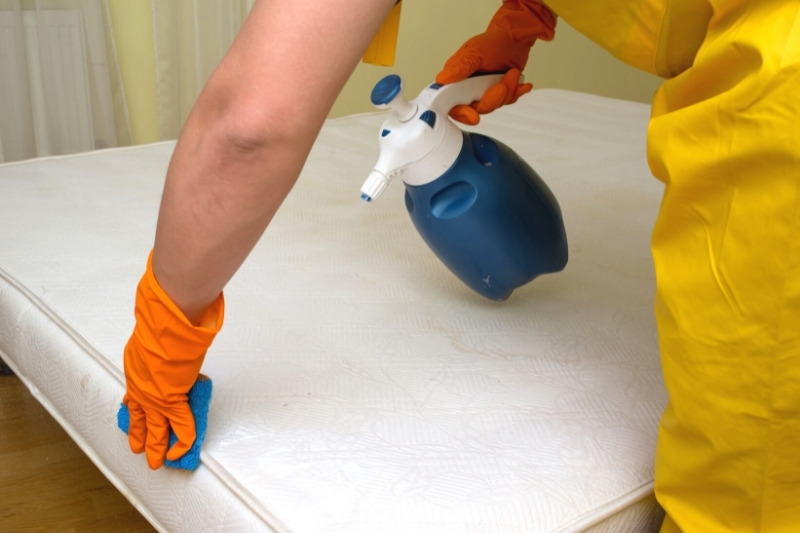
When treating or cleaning a memory foam mattress, you should adhere to the manufacturer’s advice outlined on the care label. This’ll ensure that you don’t void your warranty or damage the mattress in any way.
As a guide, you can usually use the methods noted above to clean a memory foam mattress, but you must be careful not to oversaturate the surface in liquid!
It’s generally better to avoid using water and instead use paste formulas to clean stains off the mattress. This stops too much liquid from penetrating the material.
Memory foam mattresses don’t take kindly to water and liquids, so if you’re going to use a liquid solution, make sure you half the amount you’d typically use, wring out your cloths, and use a spray nozzle to apply the liquid, so you don’t accidentally pour too much solution onto the surface!
Remember: Don’t get the mattress too wet!
If your memory foam mattress comes with a removable cover, you will need to check the cover’s care label to see how it should be washed.
In addition, it may be worth consulting the manufacturer before you carry out any cleaning work, just in case you void your warranty by removing the cover from the mattress.
How to Dry a Mattress
A mattress should be dried naturally. And depending on how you’ve cleaned and treated your mattress, the drying process can take anywhere from a few hours to a day or so to dry thoroughly.
Remember: The drying phase is an essential step that cannot be skipped!
If you don’t allow your mattress to dry properly, you’ll end up with a whole host of other problems, like mould, to deal with.
Keep these points in mind when drying your mattress:
- It’s better if you leave your mattress to air dry naturally. This will keep the mattress’ fibres intact for longer.
- Use a fan to speed up the drying process. The fan will push the air around the room.
- Open the window and door to keep the air flowing in, out, and around the mattress.
- Don’t even think about using the mattress when it’s wet because this will cause problems for you. This includes not sitting, putting stuff on the mattress, and sleeping on it.
- Use sunlight to dry your mattress. Open the curtains and allow the rays into the bedroom or take your mattress outside if you can and put it on a flat surface.
How to Remove Smells from a Mattress
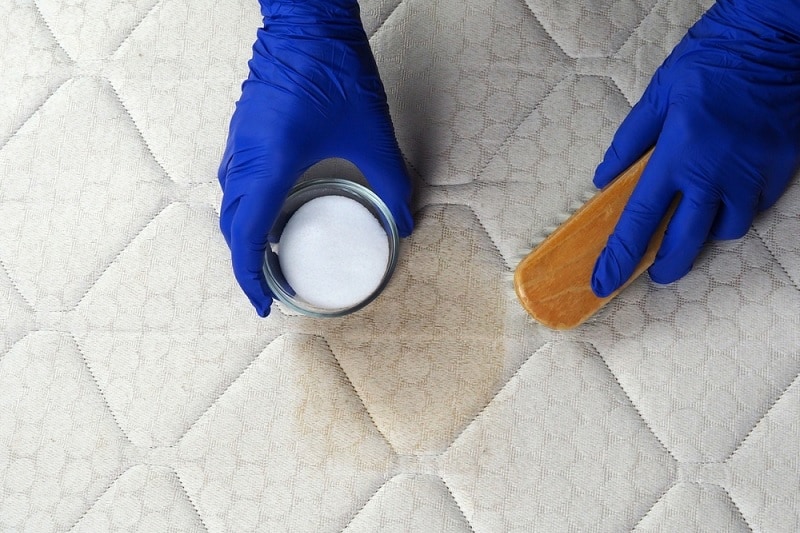
Got a whiffy mattress? You’re not alone on this one.
As mattresses are used, they get coated in sweat, foods, general odours, and stinky stains.
Naturally, the easiest way to deal with foul smells on a mattress is to clean it and treat the stains as quickly as possible. This will prevent the stains from ageing and becoming harder to remove.
Of course, some stains are more aromatic than others, like wee-wee, so when it comes to these stains, you must use the correct cleaning solution that can break down the blemish properly (an enzymatic cleaner typically).
Then you can use odour neutralisers like bicarbonate of soda to deal with any after-effects.
In addition to the above, you can strip your mattress and place it near an open window to air it out.
Or take it outside on a warm, sunny day and pop it on a level surface so Mother Nature can refresh it.
If the smell you’ve got on your mattress is that ‘new mattress’ smell, you can rest assured that the ‘new’ smell will wane in a few weeks.
But to speed the process up, you could leave your mattress where there’s plenty of fresh air so that you can remove the chemical-like smell.
Eventually, none of the methods above will work out for you, and this is a sign that you need a new mattress.
This is likely to happen when your mattress is riddled with general grime and bodily fluids, and no amount of spot cleaning, stain treatments, or deep cleaning can help the odour-filled mattress.
How Often to Clean a Mattress
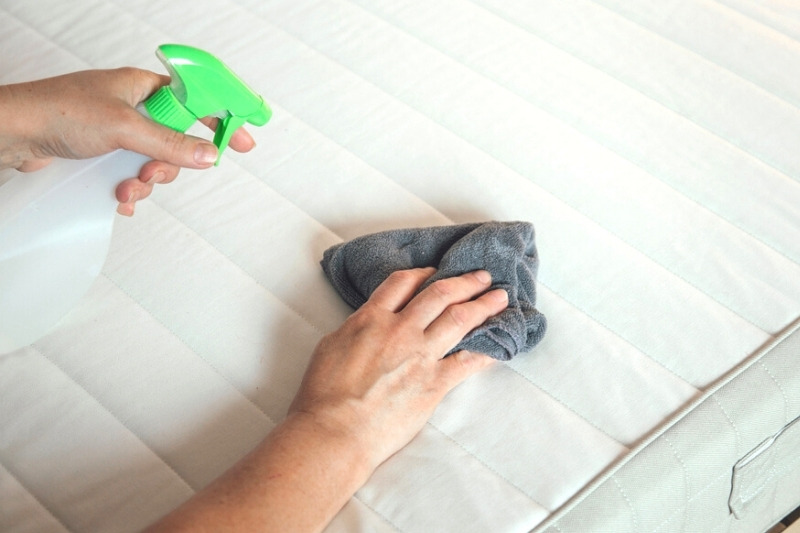
There isn’t an exact timescale for cleaning a mattress. As a rule, you should try to clean your mattress every six months at least.
In between cleans, you should hoover the mattress just to remove loose dirt from it.
It’s also imperative that you treat stains as soon as they appear so the mattress stays relatively clean and blemish free for you.
Staying on top of the cleaning not only means that you’ll get many years out of your mattress, but you’ll also find that the mattress is more pleasant to sleep in because you won’t have unpleasant aromas assaulting your nostrils every time you try and fall asleep.
Plus, if you do lots of ‘mini’ cleans throughout the year when you eventually clean your mattress properly, the job will be a lot easier and far quicker for you!
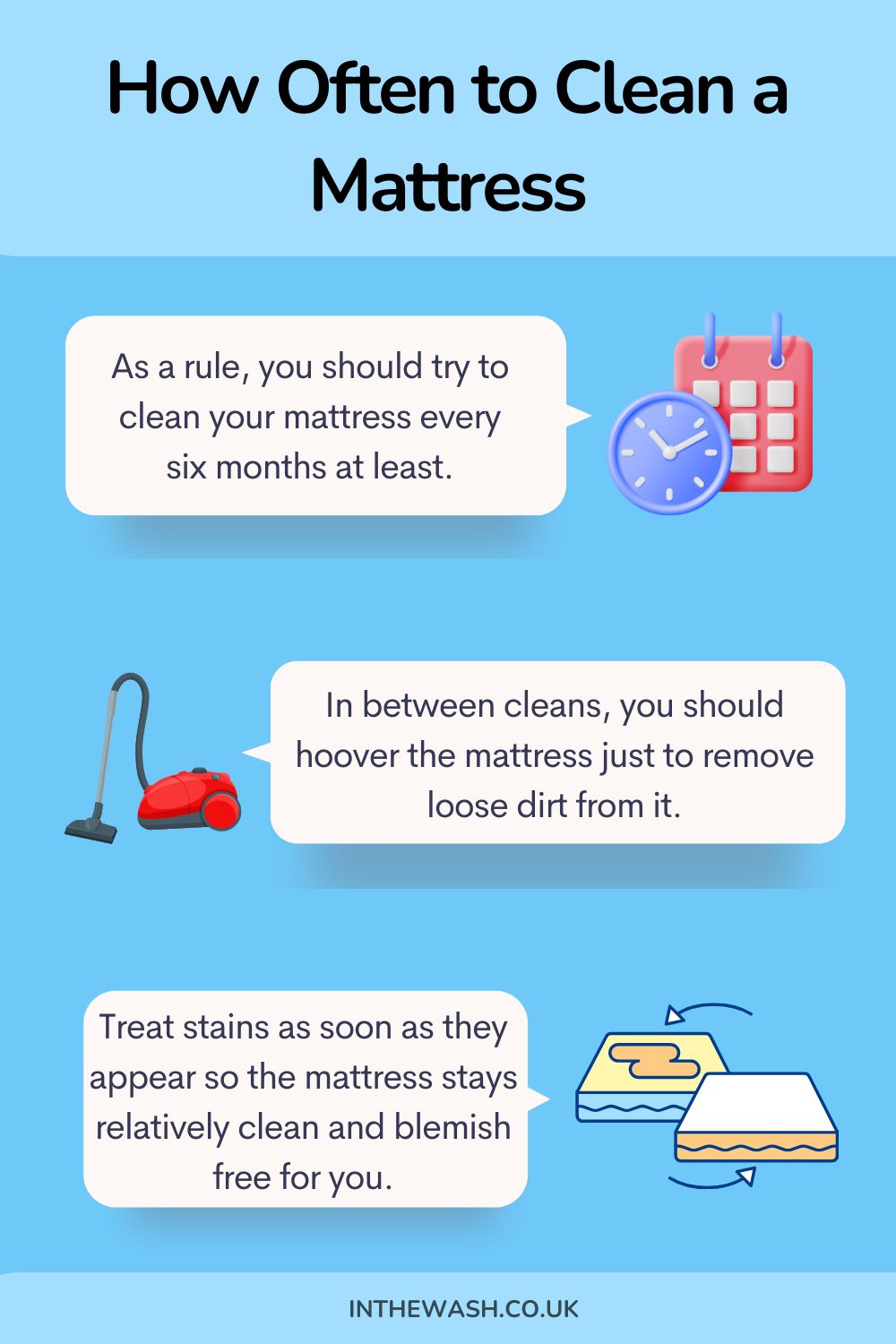

Bethan has a passion for exploring, reading, cooking and gardening! When she’s not creating culinary delights for her family, she’s concocting potions to keep her house clean!
